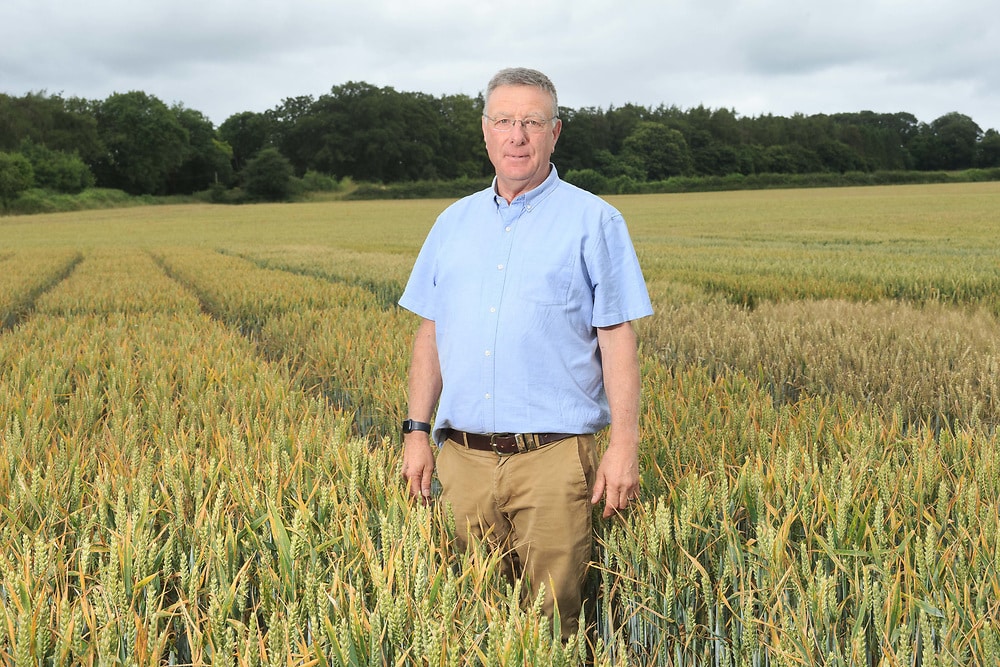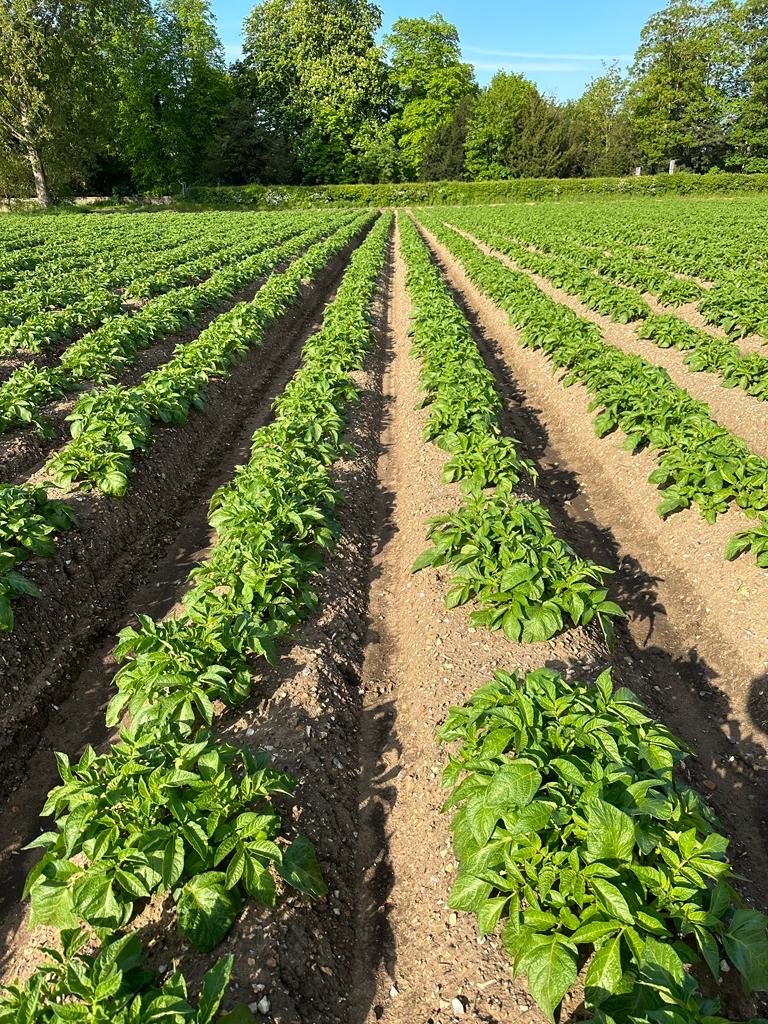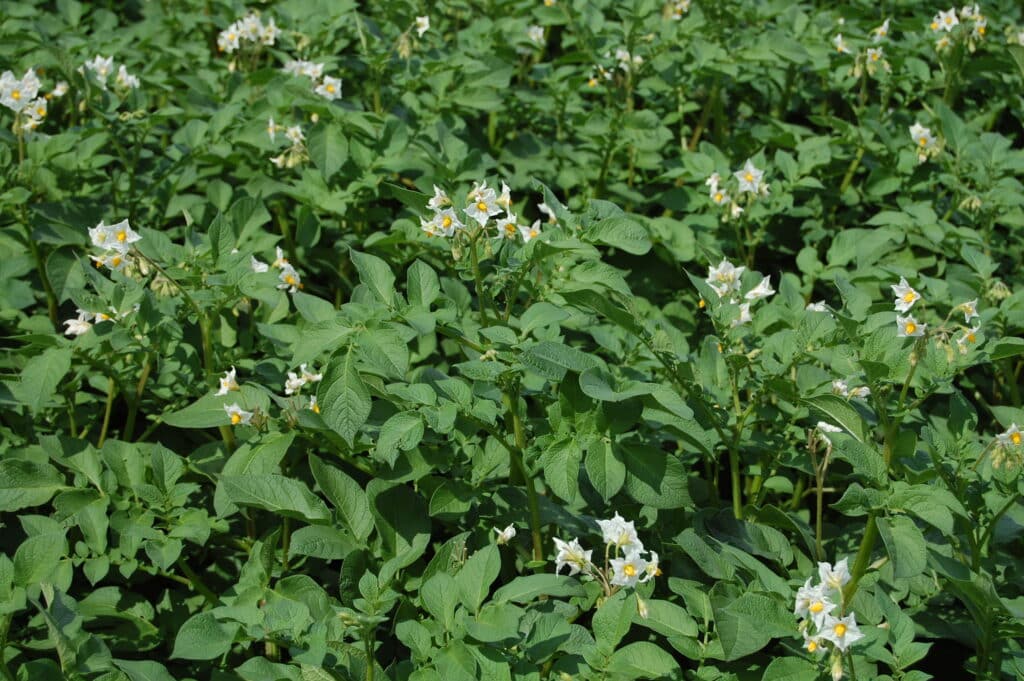Keeping it uniform – British Potato Review
Andrew Goodinson discusses how consistent planting helps to achieve standardised tuber sizes and bigger yields ...
THERE are several key actions and decisions growers can take ahead of potato planting which can have an impact on quality and saleable yield, so it’s worthwhile considering the following points before beginning planting, according to Andrew Goodinson.
Achieving a uniform crop contributes to maximising saleable yields within the size specification requested by the customer. The main factors influencing this include seed potato quality, soil conditions, inter-row spacing and planting depth.
Seed tuber depth depends on variety as stolon architecture influences tuber position, and some cultivars set their tubers below the seed, whilst others set them around the mother tuber. Consistency of the soil is crucial, and if seedbed preparation is inadequate, even the best soils will produce inferior crops, as uniform crop emergence and young plant vigour depend on a consistent, friable, warm seedbed.
“However, because of soil variations within the field, there are often areas which are drier or wetter than the rest of the field, which impact on the crops ability to grow roots and uptake nutrients,” said Andrew.
“It is also a good idea to take into account the field conditions previous crops have had on the soil structure and, for example, harvesting damage, whether there is compaction, wheeling damage, and if any mitigation has been taken.”
Variations in within-row spacing can result in some plants growing at different densities, resulting in varying tuber sizes, but as plant happens at different densities according to varietal characteristics, inter-row spacing depends on the variety being grown, he added.
“Seed companies and some processors produce their own seed spacing charts, which are a good place to start, but on-farm experience also plays an important role, so it is always advisable to undertake some seed rate trials on your own farm.
“As we need a certain number of daughter tubers per hectare, start by considering the uniformity of the mother seed. If there are six seed tubers in a 2m row, aim for 16 daughter tubers per plant. There are a number of factors which will help realise that number.”
Andrew highlights that all too often, seed potatoes are treated like a commodity rather than a valuable input. Seed is frequently transported in nets or bags loaded on curtain-sided lorries and occasionally temperatures may be unsuitable (too cold) therefore can affect tuber quality.
“When they arrive on-farm, they should be inspected and split-graded into lots of 35-45mm, 45-55mm, and those above 55mm, plus small tubers between 25 and 35mm.”
As the seed potatoes go over the grader, they can be treated with a fungicide before going in to store which will help reduce susceptibility to tuber diseases, Andrew said.
“At this stage it is often worthwhile sending a sample for disease assessment, looking for the likes of powdery scab and Erwinia spp, as these affect crop vigour and the ability to emerge and develop.
“If, for example, a crop has blackleg spores, it is advisable to plant later when soils are warmer and drier, so the mother tubers are subject to less cold stress and therefore are less susceptible to these pathogens.”
The advice is the same if Rhizoctonia is identified, as the seed potatoes need to be planted in optimal conditions so they can establish quickly and grow away. Andrew points out that when seed potatoes are inspected at source, they are not washed, therefore it is harder to assess potential disease levels.
“This means that time spent preparing and sending washed samples for on-farm assessment is well worth it as you can then make informed decisions on how and when to plant for optimum results. Sending samples for analysis is also a good investment.”
Seed choice and planting conditions are key to giving crops the best start, says Andrew.
“Thanks to the cold wet spring of 2024, for example, we saw a number of crops with ‘little potato disease’, where the crop emerges, sets early tubers along one root because conditions are not ideal, but these do not develop into commercially-acceptable sized tubers.”
Andrew adds that it is possible to identify tubers with Rhizoctonia because they are misshapen, have a crazy paving skin finish, or have black pustules (sclerotia).
“At the moment we only have one powder treatment for black-scurf and stem canker, which is Rhino DSG (flutolanil), and all new products are liquid formulations.”
Seed treatments such as flutolanil, fluxapyroxad and fludioxonil can be applied on the roller table during grading, and Andrew emphasises that they need to be applied before chitting or the onset of shoot growth, and should not be applied to newly emerging chits or shoots.
Soil-borne Rhizoctonia needs to be treated in-furrow via an on-planter spray applicator, notes Andrew.
“Both azoxystrobin and fluxapyroxad work well and they can be applied alongside biologicals at the same time,” he said.
Knowing when such treatments are called for relies on historic knowledge of the field, such as the number of potato crops grown there over the past ten years, and whether or not they were lifted late.
“The longer the gap between desiccation and lifting, the higher the risk of Rhizoctonia developing and infecting the soil.
“If you look closely at a wheat crop following potatoes, you can often see remaining potato haulms have Rhizoctonia pustules on them which may lead to the pathogen remaining in the soil and potentially putting future crops at risk.”
Creating soil conditions for uniform planting
Cultivations play a crucial role in creating the necessary tilth to be able to plant at the optimum space and depth, continues Andrew.
“If you plant at less-than-ideal conditions, the plant may be unable to develop a good root structure or maximise uptake of nutrients and water. It does not matter whether you opt for various cultivations or a one-pass operation, the aim is always to get the soil into the correct state.
“The trick is to be flexible in your ideas and adapt to what needs doing in each particular field, and the conditions may vary according to topography and microclimates.”
Technology, however, has helped to improve accurate planting, and the newer machines can work effectively at higher forward speeds.
Andrew points out that looking after the soil, even on short-term rented land, pays dividends.
“It is advisable to liaise closely with the landlord to know what has been grown on the field previously, and then take decisions on your strategy. This may include subsoiling, planting stubble turnips, Westerwold ryegrass, or cover crops.
“Some processors provide cover crop seeds free of charge to their growers as they understand the benefits they create.
“There may be advantages from applying biological soil products which, while costing in the region of £100/ha may result in a worthwhile increase in yields. Nonetheless, before recommending such activities we really need to do more trial work to explore the costs and benefits.”
Soil temperatures crucial for good establishment
When it comes to planting, soil temperatures should normally be above 7 deg C, although for early planting it is acceptable for mother tubers stored at 4 deg C to go into soils at 6 deg C as long as they are not chitted.
“If they are already sprouting, putting them into cold soils exacerbates the risk of stem canker and blackleg,” said Andrew.
“For maincrop planting, eyes should be open, but chits should not be bigger than 10mm because otherwise they are easily knocked off when planting, affecting vigour and emergence, because some of the energy needed for the plant will have already been used. There is also a risk of bacterial disease transfer.”
Devising fertiliser strategy
Nitrogen (N) drives yield but not tuber numbers. Andrew said growers are often tempted to use too much.
“N is not a panacea, and excess amounts can delay bulking because the crop is too busy growing haulm,” he said.
Deciding how much should be applied depends on the market the crop is being grown for, and any soil N supply left over from previous crops or from the application of manures should also be taken into account.
“It is time to move away from simply opting for 14:14:21 fertilisers,” said Andrew. “If you are growing a seed potato crop, it is likely to need 110kg/ha, but if you are growing ware, it can be 200kg/ha or more.”
Timing of application can also make a difference, but there are two schools of thought on which is the most effective: A single application in the seedbed or top-dressing, he notes.
“The decision should depend on the crop and your target market; early lifted potatoes and seed crops generally respond best to a single application in the seedbed, but there is an argument that if you are on light soils or irrigating, there is a benefit to splitting your application.
“Similarly, if the growing season is long, the crops benefit from top dressing.”
Timing of the second application is key to efficacy, and peak N uptake is the start of flowering, so applications should be made before or at tuber initiation (TI).
“This can be done at the same time as blight spraying, or by using a granule. If it is applied too late it delays bulking and senescence,” Andrew said.
He notes that there are times when extra N may also be required, for example if planting was undertaken in less than adequate conditions, with the result being that root systems are compromised. “This is where sap testing really becomes useful as it can indicate that the plants need some help,” he said.
Trials are currently ongoing to assess products that once applied to the foliage, capture N from the atmosphere. “We are exploring different scenarios, including the effects on crop yield and quality when applied alongside the habitual N rates, but also when lower rates are used.
“If we find that they can be used with lower N products brought on to the farm, it will also reduce the carbon footprint of the crop.”
A place for starters
Starter – or placement – fertilisers offer an opportunity to optimise nutrient uptake immediately after planting, establishing a good root system and helping the crop establish and get away, says Andrew.
One of the reasons for using placement fertilisers is because plants are unable to uptake phosphate from the soil as a result of being locked up and unavailable.
Starter fertilisers are applied in the ridge close to seed tubers and ensure key nutritional elements are immediately accessible.
“Most types of placement fertilisers include nitrogen (N), phosphate (P) and small amounts of magnesium (Mg) and zinc (Zn), but their main use is to ensure rapid P availability,” Andrew said, adding that this strategy can be particularly useful for growers using rented ground who do not have the opportunity to undertake long-term soil improvements to improve nutrient availability.
“Historically, many fields had animal manures applied and therefore have high P levels, but the nutrient may not be available to the crop. Ensuring its availability is key to tuber numbers and crop development.”
On-farm trials
Setting up some on-farm trials to tease out how different products, spacing and/or seed lots may impact on crop yield, quality and profitability is often a good idea, says Andrew, noting that different conditions can impact on efficacy.
“Once you have decided what you want to assess, it would be useful to ask your agronomist to help you set trials up so that you can see any differences which occur quite clearly.”
He advises undertaking trials on land that is as uniform as possible, because factors such as a change in soil type or even PCN hotspots could affect results.
Replicated treatments in small plots, although may be accurate, can be too time consuming for many busy commercial farmers to undertake, Andrew said.
“It is always best to site treatment in representative areas, checking any available soil or satellite maps. If the land is owned or on long-term rental, and there are arable crops in the rotation, there may also be yield maps – all of which help ensure that treatments are aligned taking into account any underlying within field variability.”
He recommends marking out the plots, noting that easy location of the research area can be made by simply using What3Words or placing a white sheet of laminated paper adjacent to the plots.
Assessments should be taken frequently throughout the growing season, and notes made and pictures taken. These can be summarised at the end of the season and the results used for comparisons.
“Timing of when measurements are made is crucial for them to be meaningful, as there are many natural variables that may affect results. Nevertheless, trials do not have to be complicated, and there are times when visual effects from basic trials can be quite clear,” he said.
“If you plant the same variety across different fields, and the seed potatoes are received from different lots, it is a good idea to put more than one lot in a field, so we can compare any differences in establishment and development.”
Experimenting with different spacing options according to tuber size and plant population are also easy to do and assess to find what works best on your farm, he adds.
“Fertiliser trials are easy to do because they entail simply switching the on-planter applicator on and off, so the rows receiving no fertiliser are clearly visible, and you can evaluate how well the product is working for you.
“Fertiliser trials can also explore the benefits and drawbacks of using different rates and different products. For simplicity, the area trialled should be the width of the fertiliser spreader, so you can apply the different rates or products by altering the settings on the tractor.”
Seedbed fungicide seed treatment trials are another easy trial to do, as differences are quickly apparent when some beds do not receive a treatment, he said.
“The aim of the trials is to give the grower more information to help making decisions going forward, and make for good winter discussions.”



